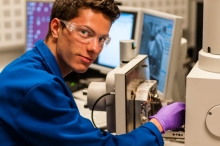
University:
Major:
Mentor(s):
Faculty Sponsor(s):
Faculty Sponsor's Department:
Project Title:
Project Description:
Turbine blades are made out of superalloys with high melting points and coated with thermal barrier coatings (TBCs), providing the blade with a thermal gradient from the surface to the superalloy and protection against oxidation. This coating allows the turbine to operate at higher temperatures, and therefore increases the efficiency of the operating system. Sand, dust and ash particles in the air, referred to as calcium-magnesium-alumino-silicates (CMAS), have a melting point of ~1240°C and can melt on the surface, leading to infiltration of the TBC and initiation of cavitation, finally causing delamination of the TBC. To minimize the restricting influence of the CMAS-melting, an understanding of the associated failure mechanisms is required. Multiple datasets of cavitation were taken from samples that have been exposed to turbine-like conditions (high temperature thermal cycling, global tensile stresses, lateral thermal gradients, etc.) to investigate the mechanism. Furthermore, a single crystal sample of the superalloy René N5 received multiple heat treatments at temperatures ranging from 750°C to 1250°C, and was characterized by the volume fraction of the γ’-precipitates in the γ-matrix. The volume fraction was plotted against the temperature to correlate the volume fraction of a sample with unknown thermal background to a particular temperature. After processing scanning electron microscope (SEM) images, cavity size analysis using ImageJ was performed; several methods, including energy dispersive spectroscopy (EDS) and X-ray diffraction (XRD) were employed to measure the γ’-precipitate volume fraction.
